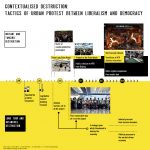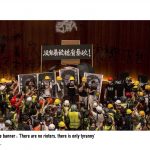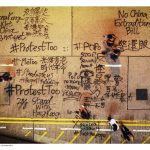Hoi Yee Cheung
- Faculty of Architecture
- Urban Studies
- ma
- Contextualised Destruction: Tactics of urban protest between liberalism and democracy
- Tutor(s): Leonard Ma
This thesis investigates the role of the temporary use of public spaces in social movements for crowd engagement, and analyses how political opinions can be expressed in space through different protest tactics. Although both traditional protest tactics and those used in the 2019 Hong Kong pro-democracy protests aimed to block the flow of movement across cities, they used different methods of achieving this goal. Traditional tactics aimed to block the flow of transport across the city, whereas the 2019 Hong Kong protests targeted two immobile spaces centralised within the flow of capital in the city; the railway network and the airport. The aim of this was to disrupt the city’s ‘normal’. Through the cooperation of non-violent and violent strategies, these various forms of tactic have intertwined with the daily practices of Hong Kong lives since the protests started in the city a year ago. Studying the destruction caused by the Hong Kong 2019 protests allows us to develop new insights into the configuration of urban spaces.

The instant and tangible destruction caused by protest tactics, triggered by events across the MTR railway system (MTR) in Hong Kong.
The night of the ‘Train Attack’ at Yuen Long railway station in July was a crucial incident of the 2019 protests. Protesters using the public transport system were attacked violently by gangsters – whose affiliation remains unclear. This triggered frustration at police inaction. In response to which, a protest was organised at Yuen Long on the 21st August. This escalated into a direct conflict between protestors and police.
The MTR system had previously not been targeted by protesters, continuing to provide a reliable means of connectivity for the city. However after events in August, later inflamed by growing intervention by Chinese authorities, MTR became an important focal point impacting the whole of Hong Kong society.
Although protesters were themselves users of its services, they sacrificed their own access to urban connectivity, attacking the system so as to trigger traffic jams affecting 42 per cent of daily urban transit.
The government took measures to try and restrain the destructive nature of protesters’ actions, implementing a ban on the use of face masks – face masks were worn by almost all protestors to protect their identity from the scrutiny of the state. Their response was furious, triggering a move towards visible destruction of the fabric of the city.
They attacked station buildings, and MTR had to reduce its service schedule.
Because MTR is a transport hub crucial to a large number of citizens’ daily activities, this reduction in services resulted in a form of de facto curfew. For the next two months, citizens had to both reduced their daily activities, and reordered their routines, conducting activities like dining in the night.
The long term and intangible destruction caused by the protest at the Hong Kong International Airport (HKIA)


The protesters found an alternative and aggressive way to ensure their voices were heard, whilst applying pressure to advance the democratisation process through a strategic plan which threatened to destroy the economy when the protests unable to gain conclusive responses from the government for months. They utilised the global visibility of protest action at the airport to mobilise international support. Protesters aimed to deepen local market downturns, thereby triggering pressure on internal authorities through damaging the city’s economic interests – that which the Hong Kong government values most. Protests at the airport successfully caused a two-day suspension of international airport operations. This had two key results.
First, a decrease of Chinese tourism after travel warnings were issued by mainland China against Hong Kong – Chinese tourism accounts for the majority of the city’s annual visitors.
Second, the airport shut-down added to the growing economic fragility of the city, due to the gradual erosion of Hong Kong’s reputation as a business-friendly environment. That reputation is built upon US recognition of its socio-economic status as an exceptional free-market territory within communist China. Maintaining confidence in that reputation is integral to the long-term stability of its role as a global financial hub.
The disruption caused by protestors drew attention to China’s visibly increasing influence over Hong Kong’s economic sphere, prompting a negative reaction amongst rating agencies. In turn, this threatened a major downturn in terms of trade, tourism, and finance.

The 2019 protests have also illustrated how targeting disruption to the flow of financial capital is a more effective tactic than targeting flows of human capital. This was particularly evident in the case of Hong Kong, where the government actively devalues human capital, as evident from its rhetoric towards protestors whom it claimed ‘have no stake in society’. In reality, the majority of protestors represent either ‘future labour’ (aged below 30), or ‘professional labour’ (tertiary educated and above).
If democracy is inherently unstable, then recent events in Hong Kong have born witness to a dramatic downward spiral of socially destructive forces. Protest action against the centralised abuse of power resulted in greater abuse of citizens’ rights, which, in turn, has entrenched the position of protestors. The degree to which protestors and authorities appear locked in the binary conflict was dramatically staged on the 1st July when protesters invaded the Legislative Council placing a banner at the centre of the chamber, it stated: ‘There are no rioters, there is only tyranny’.

The thesis does not try to describe all aspects of recent events in Hong Kong, instead, it points to specific shifts in the tactics of protestors, analysing how these have impacted Hong Kong society more broadly. In doing so, it attempts to focus on the urban not only a site, but also a means of protest.
In doing so, it addresses the impact of social media and globalisation on society, specifically how media representations of MTR or HKIA were targeted by protesters, blurring of the distinction between the production and consumption of space. They attacked each site’s status as urban transportation hubs, using the implosion of those reputations as powerful protest tools.
The comprehensive nature of digital communication technologies aided protestors’ tactics, enabling them to perform these shifting urban conditions to an international audience. It was this wider visibility that helped them to successfully apply pressure upon the government, provoking a hard line response by authorities that merely served to increase the damage to Hong Kong’s wider reputation. These protest tactics revealed the power of globally connected layers of urban space, cross-cutting economic, communication, and transport systems.
